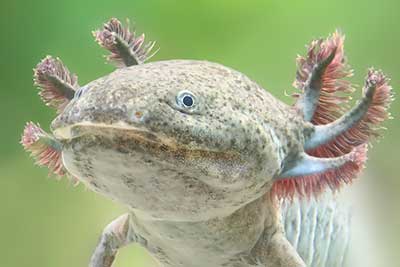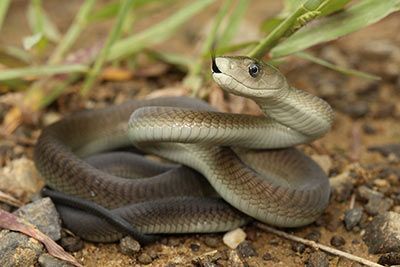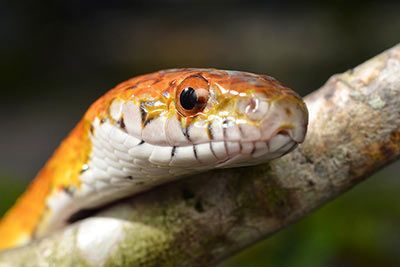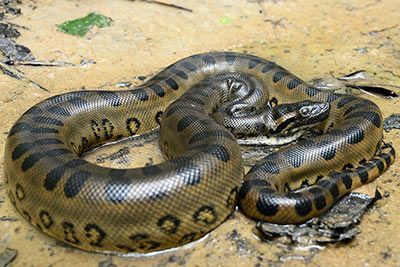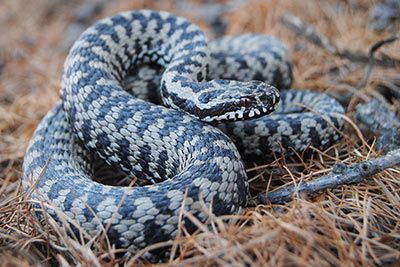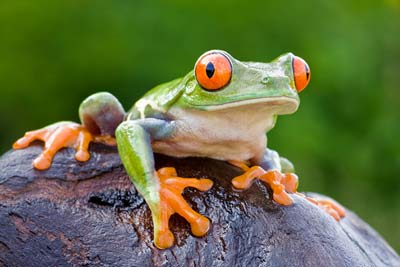Adder
Common Adder Facts
| Size | 20-28 inches (50-70 cm) |
| Speed | Unknown |
| Weight | 3.5-10.5 ounces (100-300 grams) |
| Lifespan | 15-25 years |
| Food | Mice, birds, lizards, frogs |
| Predators | Ermine, polecat, stoat, fox, birds of prey |
| Distribution | Central Europe, North Europe |
| Habitat | Forest edges, moors, heathland landscapes |
| Class | Reptiles |
| Order | Squamata |
| Family | Viperids |
| Scientific name | Vipera berus |
| Characteristics | Diuarnal venomous snake with zigzag pattern |
Main Characteristics
The adder is a small to medium-sized venomous snake. It is very shy, but if it feels threatened, it will bite. Its venom isn't life-threatening for adults. However, a bite can be dangerous for children, older people, small dogs and cats. Adders and aspis vipers are the only two venomous snakes that live in Germany.

Distribution
The adder is a very common snake in Central and Northern Europe. Of all the snakes in the world, it has the largest natural range. It stretches over 5,000 miles (8,000 km) from west (Western Europe) to east (Russia). It is the only snake species that can survive north of the Arctic Circle. To be more precise: up to 120 miles (200 km) north of the Arctic Circle. It has adapted very well to cooler temperatures, but it can also be found in the warm south of Europe.
Germany
In Germany, the adder can be found in northern Germany (heathland), in the low mountain ranges in the east and in parts of southern Germany (Black Forest, Swabian Alb, Bavarian Forest, Alps and foothills of the Alps). In the Alpine region, the monochrome black adder is very common.
Austria
In Austria, the adder is widespread in all federal states - except Vienna and Burgenland.
Switzerland
In Switzerland, adders are found in the Alpine region.
Habitat
Adders prefer forest edges, moors, heaths and mountain meadows as a habitat. It loves areas with high humidity and cold nights and hot days.
Life Style
The adder is a diurnal solitary animal. It spends most of its time on the ground. When it's 86-91 degrees Fahrenheit (30-33 degrees Celsius), it feels most comfortable. To sunbathe, it sometimes climbs small bushes or hills. It does surprisingly well with cold temperatures. For a short period of time it can even survive 23 degrees Fahrenheit (-5 degrees Celsius). In winter, however, it prefers to stay in frost-free hiding places. It is rather shy and runs away – given that the path is clear.

Anatomy and Appearance
Size and Weight
Adders grow to a length of 20-28 inches (50-70 cm). Their body size depends on the habitat: they tend to be smaller in the northern regions and larger in the southern regions.
Color
Adders are sometimes tricky to identify. Their color can vary a lot. They can be gray, brown, blue-gray, yellow, orange, reddish brown or even black. Females are usually brown, while males are typically gray in color.
Zigzag Pattern
Almost all adders have one thing in common: the zigzag pattern on their backs. In some it is narrow, in others it is broad. In some it's more of a wave and in some they look more like a chain made from diamonds. But it's always a zigzag pattern. Only in the solid black adder and the red copper adder it isn't visible.
Head
Adders often have an X- or V-shaped marking on the back of their heads. With the V, the tip points towards the mouth.
Teeth
Adders possess hollow, tubular teeth that can fold and unfold, connected to a poison gland on their jaw. This allows the venom to flow through the teeth and into the bite wound.
Skin and Scales
The adder's skin is rather dull. The scales protrude slightly from the body.
Adder or Grass Snake – What’s the Difference?
The grass snake has a ring-shaped, bright pattern around its neck. It does not have a zigzag pattern on its back. Their pupils are round.

Adder or Slow Worm – What’s the Difference?
The slow worm has no zigzag pattern, a narrow head, smooth, shiny skin and small, round eyes.

Diet
Adders are carnivores. They primarily feed on small rodents and vertebrates that move on the ground, mainly mice and ground-nesting birds. They also eat lizards and frogs.
Behavior
How Do Adders Hunt?
Adders are clever. They adapt their hunting technique to the habitat, the season and their prey. They either actively hunt mice or frogs, or they patiently wait for a delicious treat to come their way.
What Do Adders Do in Winter?
Before winter, adders look for a place that offers protection from frost and predators. When the temperature drops, they enter a state of torpor that lasts for 4-7 months. In Germany this happens from October or November. From February onwards the temperatures are high enough again for them to wake up. 1. By April at the latest, they will resume their activities.
Adaptation to the Cold
Adders are perfectly adapted to the cold. They have even set a record by being the northernmost living snake species. For a short period of time they can survive 23 degrees Fahrenheit (-5 degrees Celsius). At 29 degrees Fahrenheit (-1.5 degrees Celsius) they can even move around and defend themselves.

Venom
Are Adders Venomous?
Yes, adders are venomous. Their poison is strong, yet they can only produce small quantities of it.
Are Adders Aggressive?
Many people are afraid of adders because they are venomous. However, the risk of being bitten is very low. They're not aggressive and rather avoid contact with people. When they feel trapped or threatened with no way to escape, they bite as a means of defense. Prior to this, they give a warning signal: they bend their front body in an S shape and make a hissing sound. Then, you should start to gradually retreat and move in the direction you came from.
Are Adders Dangerous?
For adults, the bite of an adder isn't life-threatening. It doesn't have enough venom. For becoming life-threatening, a person would have to be bitten by at least five adders in a row. Plus, the adders would need to spray all of their venom. It takes a lot of energy for the snake to produce it, so it usually uses only a small amount of it or none at all (then it's called a “dry bite”). However, the bite of an adder can be life-threatening for children and old, weak or sick people. Always set off an emergency call!
How Dangerous Is the Adder for Dogs?
The bite of an adder can be life-threatening for dogs. The venom is actually intended to kill mice and frogs, which are much smaller and lighter than dogs. However, the amount is still enough to cause serious physical illnesses in dogs. Swelling, issues with balance and feeling disoriented, paralysis, difficulty breathing, or even a cardiac arrest may happen as a consequence.
How Dangerous Is the Adder for Cats?
Cats are twice as likely to survive snake bites as dogs. In 2020, scientists discovered that this is due to blood clotting. The venom spreads more quickly in dogs and much slower in cats (and humans). Nevertheless, the bite of an adder can be dangerous for cats, too.
How To Avoid Adders in the Wild
Adders are very shy and typically keep their distance from humans. Bite accidents often occur when they feel threatened, usually because they are trapped, stepped on, or chased. It's safest to stay on the forest paths. Be cautious when wandering off forest trails to search for berries or mushrooms and always watch your step.
What to Do If You've Been Bitten?
Stay calm and move as little as possible. The lower the heart rate, the slower the venom spreads throughout the body. Immediately dial 911. Make sure to apply a cold compress to the wound, but avoid putting pressure on it. Avoid tying off body parts, as it can increase the amount of venom in the affected body part and cause it to die. Don't disinfect the wound with alcohol, but with iodine. For pets, call the vet. Carry your pet if possible.
Can You Kill Adders?
In Germany, adders are safeguarded under the Federal Nature Conservation Act. It is illegal to harm or disturb them in any way.

Senses and Abilities
Senses
Adders have a very good sense of smell and a very good sense of sight.
Life Expectancy
Adders live 15-25 years.
Enemies and Threats
Natural Enemies
Adders have many enemies, especially birds of prey and predators. They include: Common buzzard, Montagu's harrier, black kite, short-toed eagle, eagle owl, carrion crow, white stork, crane, chicken, polecat, stoat, badger, red fox, hedgehog, cat, wild boar, grass snake and dice snake.
Habitat Loss
The adder is not (yet) considered an endangered species. Unfortunately, the number of these animals is declining as their habitat shrinks due to human activities.
Importance for the Ecosystem
Adders are very important for the balance in nature. They're great at hunting mice and other rodents.

Reproduction
Mating season
Adders mate between April and May. This is when they are most commonly seen.
Ovoviviparous
Adders are one of the few ovoviviparous reptiles. Ovoviviparous means: live egg birth (“ovum” = “egg”, “vita” = life and “parere” = “to give birth”). Females don't lay eggs but incubate them in their womb.
Eggs
The adder's eggs don't have a hard shell, but consist of a soft exterior.
Birth
The babies are born between August and October. Shortly after birth, the little adders pierce the soft egg shell. They are 3-5 inches (7-12 cm) long and can immediately take care of themselves.
Fun Facts
In Germany, the adder is “Reptile of the Year 2024”.
The Common European Adder Is Related To:
- Asp Viper
- Caucasus Viper
- Horned Vidper
- Meadow Viper
Animals in the Same Biome:
- Badger
- Carrion Crow
- Cat
- Chicken
- Common Buzzard
- Common Raven
- Dice Snake
- Ermine
- Eurasian Eagle-Owl
- European Polecat
- Grass Snake
- Hedgehog
- Red Fox
- White Stork
- Wild Boar







